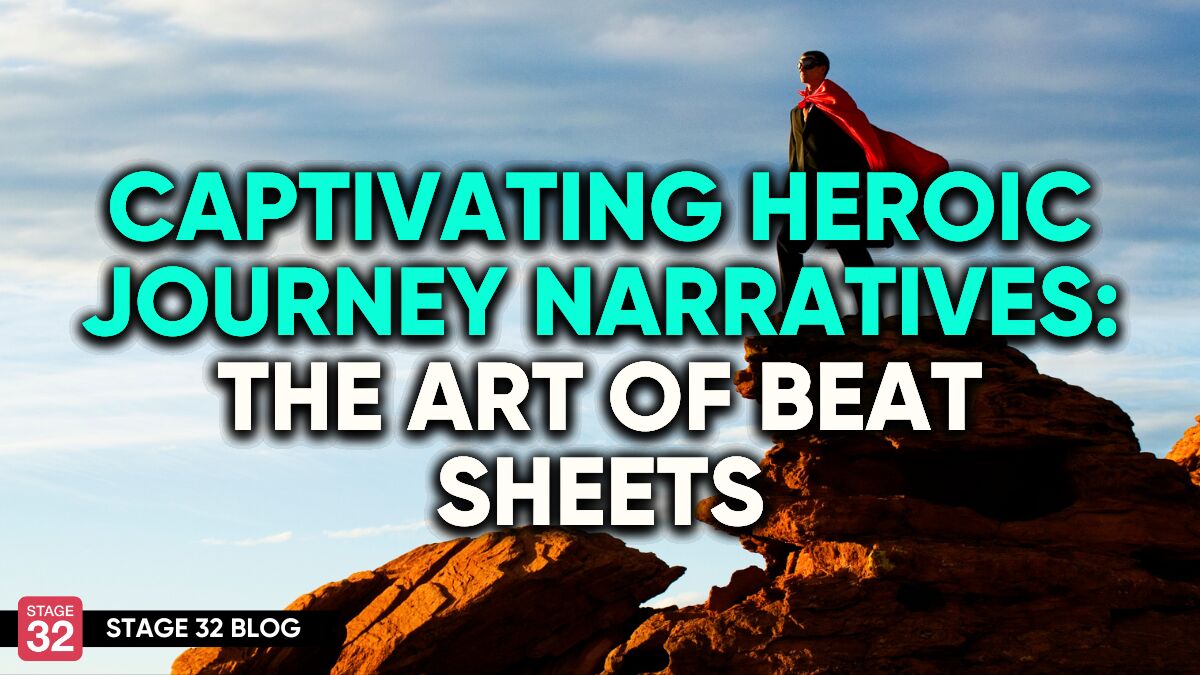Captivating Heroic Journey Narratives: The Art Of Beat Sheets
Crafting captivating narratives is an art form that elevates screenwriting to new heights. If you’re seeking success in screenwriting, understanding the concept of beat sheets is paramount. These guides provide a roadmap for plot development and creating engaging narratives. In this exploration of the Heroic Journey as a beat sheet in screenwriting, I will unravel their significance, their applications, and how they intertwine with the timeless allure of the Heroic Journey.
Join me on this final journey of our blog series, as I reveal the magic behind weaving captivating heroic narratives for global audiences.
Unveiling the Screenwriter's Map
A Heroic Journey Unfolded
A Heroic Journey unfolds through a series of predictable stages that form the backbone of countless stories. It begins with the 'Ordinary World,' where you see the Hero/Heroine in their natural environment, followed by the 'Call to Adventure,' which disrupts their routine. Reluctance often marks the 'Refusal of the Call,' but the 'Meeting with the Mentor' provides the Hero/Heroine with the confidence to cross the 'Threshold' into a new, challenging world.
Here, they encounter 'Tests, Allies, and Enemies' that shape their character. The 'Approach to the Inmost Cave' represents the Hero/Heroine’s preparation for the central ordeal, leading to the 'Ordeal' itself—a pivotal midpoint of change. Emerging with the 'Reward,' the Hero/Heroine takes the 'Road Back,' which involves a 'Resurrection' or final test, before returning 'With the Elixir,' transformed and ready to improve their Ordinary World.
Beat Sheet Basics
Beat sheets are the scaffolding of screenwriting—the blueprint from which compelling narratives are constructed. At their core, beat sheets break down a screenplay into individual 'beats,' or significant story events that affect, change, and turn the plot in a new direction. Each beat represents a point of emotional change, decision, or revelation that propels the Hero/Heroine forward.
Typically, beat sheets are used in the planning stages, allowing you to outline the key moments of your story and ensure a coherent structure before delving into the details of dialogue and scene writing. This tool is essential for pacing because it distributes your story's dramatic highs and lows, builds tension, and guides the audience across an emotional journey.

The Beat Sheet Blueprint
Crafting the Skeleton of Your Story
Creating the skeleton of your story with a beat sheet involves identifying the key plot points that will form your narrative's spine. Start with broad strokes, sketching out the opening image, the inciting incident, and the first act's turning point which thrusts the Hero/Heroine into a new world or situation. The midpoint is pivotal, where the stakes rise, and the Hero/Heroine’s goal becomes clearer. As you move into the second half of the second act, the Hero/Heroine encounters significant obstacles, leading to the point where everything appears hopeless.
The third act begins with the final push, culminating in the resolution where the Hero/Heroine faces their greatest challenge. The denouement follows, tying up loose ends and leaving the audience with a final, lasting impression. Each beat is a building block, and when constructed correctly, these beats form a robust and compelling narrative.
Timing the Emotional Pulse
Timing the emotional pulse of your screenplay is akin to a composer orchestrating a symphony's movements. The beat sheet places emotional highs and lows at strategic points, ensuring your audience remains engaged from beginning to end. At the outset, you set the tone and introduce the world. As you approach the first act's resolution, you build tension to captivate viewers.
The midpoint acts as a crucial emotional peak, revealing a truth or challenge that deepens the narrative. As your Hero/Heroine faces setbacks, the story's emotional pulse dips, creates empathy, and the audience gains interest in their journey. Finally, the resolution is the most intense emotional moment and delivers the proper payoff. By mapping these beats, you keep the audience's emotions in sync with your story by controlling the story’s pacing.

The Heroic Path in Scenes
Integrating the Heroic Journey
Integrating the Heroic Journey into your beat sheet involves mapping out the Hero/Heroine’s transformation across your script. Begin by identifying the ordinary world and the call to adventure within your opening scenes. This sets the stage for the journey ahead. As the story progresses, each beat aligns with a stage in the Heroic Journey.
The refusal of the call, meeting the mentor, and crossing the threshold can be individual scenes or a sequence of events that build momentum.
The tests, allies, and enemies your Hero/Heroine faces will form the bulk of the middle act, providing ample opportunity for character development and thematic exploration.
As you approach the resolution, the ordeal and the reward deliver the promise of transformation, leading to the Hero/Heroine’s return with the elixir, where new wisdom gained is integrated into the ordinary world, leaving both the Hero/Heroine and the audience fundamentally changed.
Beats as Story Stepping Stones
Beats are stepping stones guiding the audience through the narrative river, each one strategically placed to support the weight of your story. Think of these beats as checkpoints or milestones within the Hero/Heroic Journey that ensure the plot progresses properly and maintains momentum. Each beat is a moment of change, whether it's the Hero/Heroine making a crucial decision or facing a new challenge that alters their course.
By planning these beats, you ensure the audience follows and the journey feels natural and compelling.
As the Hero/Heroine hops from stone to stone, each leap is both a risk and a triumph, drawing the audience deeper into the story. A well-crafted beat sheet spaces these moments to maximize engagement and keeps audiences engaged, eager to experience the next steps.

The Rationale Behind the Rhythm
Why Beats Resonate with Audiences
Beats resonate with audiences because they mirror the rhythm of life itself. Like reality, experiences are punctuated by defining moments and beats provide the emotional and narrative punctuation in your stories. They're the moments that audiences remember—the first kiss, the final battle, the triumphant return. These are the instances where an audience's heartbeat syncs with the Hero/Heroine’s journey, creating a shared emotional experience.
Beats also serve as signposts that keep the audience oriented within the story's structure, building anticipation, and satisfaction. A well-timed beat reignites interest, provides clarity, and deepens investment in the character's plight. By crafting beats that tap into universal emotions and experiences, screenwriters forge a connection with the audience, making your story's highs more exhilarating and its lows more impactful.
It's this rhythmic dance between anticipation and fulfillment that leaves a lasting impression on global audiences.
Structuring for Success
Structuring for success in screenwriting means aligning your story’s beats with the expectations of your audience. Audiences have an innate sense of rhythm when it comes to storytelling, and they feel when a beat hits too early or too late. By placing key turning points at the structural joints of your script—like the transition from the first to the second act, or the start of the final act—you satisfy the audience's subconscious need for order and progress.
This doesn't mean your story has to be predictable. On the contrary, within this structure, there is ample room for creativity. The trick is balancing originality with the comforting cadence of a familiar tune. When you structure your story properly, the audience is engaged and rides the emotional waves of your script.

The Heroic Journey Reimagined
Beats Reflecting the Archetypal Quest
Beats in the Heroic Journey provide a narrative rhythm that resonates with audiences. This pattern, ingrained in the human psyche through centuries of storytelling, offers a familiar path of trials, growth, and transformation. By crafting beats that align with the Heroic Journey, you tap into a rich resource of storytelling. The audience instinctively understands the significance of the ‘Call to Adventure’ or the depth of despair in the ‘Belly of the Whale.’
These archetypal moments act as emotional signposts, guiding viewers through the protagonist’s internal and external quests. Even when reimagined for contemporary stories, these beats retain their power because they reflect the fundamental experiences of challenge and triumph that are central to the human condition.
When a story echoes this timeless cycle, it strikes a chord that is fresh and compelling.
Questioning the Conventional Path
Questioning the conventional path of the Heroic Journey allows screenwriters to explore fresh narrative territories. While the archetypal structure forms a universal backbone, innovation within this framework leads to stories that are unique and relatable. By shifting, combining, or omitting certain beats, writers subvert audience expectations and breathe new life into well-worn paths.
For example, a Hero/Heroine rejects the call to adventure multiple times or faces their biggest ordeal earlier in the story than anticipated. The key is maintaining the emotional truth of the journey. As long as the beats resonate with the Hero/Heroine’s growth and central themes, your path can veer into uncharted territory.
This story strategy gives you a unique story (unconventional quest), reinvigorates the narrative, and invites the audience to engage with the story on a deeper level.
If you missed the other three pieces in this series, you can find them all below:
Part 1: Unveiling the Heroic Journey: A Template for New Screenwriters
Part 2: Unleashing The Heroic Journey: A Framework For Screenwriters
Part 3: Understanding The Heroic Journey: The Importance Of Character Arcs
Let's hear your thoughts in the comments below!
Got an idea for a post? Or have you collaborated with Stage 32 members to create a project? We'd love to hear about it. Email Ashley at blog@stage32.com and let's get your post published!
Please help support your fellow Stage 32ers by sharing this on social. Check out the social media buttons at the top to share on Instagram @stage32 Twitter @stage32 Facebook @stage32 and LinkedIn @stage-32
| It's Time For Our Cannes 2024 Recap! |
| Coffee & Content: Are You Being Intentional In All Of Your Choices? |
Search Stage 32 Blog
There are now 3760 blog posts for you to enjoy. Search them all by tags below.
Acting, Advice, Cinematography, Coffee & Content, Composing, Contests, Distribution, Featured, Filmmaking, Financing, Inspirational, Networking, Producing, Screenwriting, Success Stories, Tips, Trending,Relevant Tags
Recommended Articles

Celebrate the February 2025 Stage 32 Community’s Successes

Confessions of a Script Doctor

Stage 32 Certification: Ladders Are Meant To Be Climbed

Redefine Love in Your Creative Process: 5 Key Tips

Coffee & Content: The Power of Supporting Fellow Creatives

A Theme Runs Through It

Announcing the 5th Annual TV Drama Screenwriting Contest

Follow The Yellow Brick Road To Your Goals!

How I Made a Short Film with a $0 Budget






